
AS NEW with 31,232 miles. PERFECT!
How the Car was Built
Pluses of the 1952-1954 Henry J Corsair: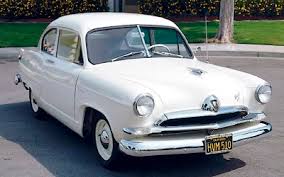
Minuses of the 1952-1954 Henry J Corsair:
Production of the 1952 Henry J Corsair:
7,600
Production of the 1953 Henry J Corsair:
8,500
Production of the 1954 Henry J Corsair:
800
Specifications of the 1952-1954 Henry J Corsair:
Wheelbase, inches: 100.0
Length, inches: 181.5
Weight, pounds: 2,370-2,405
Price, new: $1,399-$1,517
Engines for the 1952-1954 Henry J Corsair:
| Type | Size | Horsepower | Years |
| sv I-4 | 134.2 cid | 68 | 1952-1954 |
 SPECIFICATIONS: L head four cylinder engine. 25 hp pressurized vacuum tank fuel system. 12 volt Northeast electric starter/generator unit. 2 wheel brakes, 32X4 tires.
SPECIFICATIONS: L head four cylinder engine. 25 hp pressurized vacuum tank fuel system. 12 volt Northeast electric starter/generator unit. 2 wheel brakes, 32X4 tires.There are more Model Ts still running today than any other automobile from the same era. This Model T served as “Sir Percy Goodfellow’s” ride in our air show for many years.
1908 was a year of great significance and historic importance as Henry Ford's Ford Motor Company from Detroit USA produced its first Ford Model T motor car. The car was also known as the Flivver or Tin Lizzie.
This was now the age when motor cars came into popular usage, not only the rich were able to have enjoy the joys and freedoms of motoring, when, as some say, “It put America on Wheels”. There were two main reasons for this change to the American society they were:
1) 1) It was the birth of the assembly line
2) 2) A ready market was also created by Henry Ford paying his workers a wage that was proportional to the cost of the car.

 On May 26, 1927, Henry Ford watched the fifteen millionth Model T Ford roll off the assembly line at his factory in Highland Park, Michigan. Since his "universal car" was the industrial success story of its age, the ceremony should have been a happy occasion. Yet Ford was probably wistful that day, too, knowing as he did that the long production life of the Model T was about to come to an end. He climbed into the car, a shiny black coupe, with his son, Edsel, the president of the Ford Motor Company. Together, they drove to the Dearborn Engineering Laboratory, fourteen miles away, and parked the T next to two other historic vehicles: the first automobile that Henry Ford built in 1896, and the 1908 prototype for the Model T. Henry himself took each vehicle for a short spin: the nation's richest man driving the humble car that had made him the embodiment of the American dream.
On May 26, 1927, Henry Ford watched the fifteen millionth Model T Ford roll off the assembly line at his factory in Highland Park, Michigan. Since his "universal car" was the industrial success story of its age, the ceremony should have been a happy occasion. Yet Ford was probably wistful that day, too, knowing as he did that the long production life of the Model T was about to come to an end. He climbed into the car, a shiny black coupe, with his son, Edsel, the president of the Ford Motor Company. Together, they drove to the Dearborn Engineering Laboratory, fourteen miles away, and parked the T next to two other historic vehicles: the first automobile that Henry Ford built in 1896, and the 1908 prototype for the Model T. Henry himself took each vehicle for a short spin: the nation's richest man driving the humble car that had made him the embodiment of the American dream.Midway through the century, cars had become a central feature of life for young people. The cars owned by the students of Winfield High School in the fifties are typical of every where in America at that time. It was mobility, status, challenge, and social freedom. It certainly hurt our football team at the time. A typical excuse for not playing on the football team was that a student had to work to earn money to pay for their car. When asked why they needed a car, the answer was invariably: to get to work!
After a century of the automobile, we can begin to assess the effects of long term transport by internal combustion. Nearly every aspect of our lives has developed around this technology. Only now, are we seeing new digital communications technologies, of the internet and beyond, that may eventually displace some of the functions of the automobile and replace our current problems with a new set that you, our grandchildren, will be charged with solving. Ask your grandparents about their first car. I'm sure you will get to hear a great story.
The horse racing facilities were quickly converted to  the new, faster, more dangerous, and thus more exciting, motor racing.
the new, faster, more dangerous, and thus more exciting, motor racing.
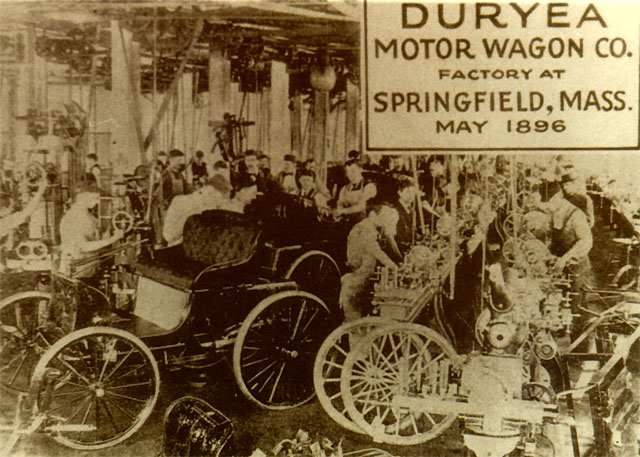 The factory which produced the 13 Duryeas. In 1898 the brothers went their separate ways and the Duryea Motor Wagon Company was closed. Charles, who was born in 1861 and was eight years older than Frank had taken advantage of Frank in publicity and patents. Frank went out on his own and eventually joined with Stevens Arms and Tool Company to form the Stevens-Duryea Company which was sold to Westinghouse in 1915. Charles tried to produce some of his own hare-brained ideas with various companies until 1916. Thereafter he limited himself to writing technical book and articles. He died in 1938. Frank got a half a million dollars for the Westinghouse deal and lived in comfort until his death in 1967, just seven months from his 98th birthday.
The factory which produced the 13 Duryeas. In 1898 the brothers went their separate ways and the Duryea Motor Wagon Company was closed. Charles, who was born in 1861 and was eight years older than Frank had taken advantage of Frank in publicity and patents. Frank went out on his own and eventually joined with Stevens Arms and Tool Company to form the Stevens-Duryea Company which was sold to Westinghouse in 1915. Charles tried to produce some of his own hare-brained ideas with various companies until 1916. Thereafter he limited himself to writing technical book and articles. He died in 1938. Frank got a half a million dollars for the Westinghouse deal and lived in comfort until his death in 1967, just seven months from his 98th birthday.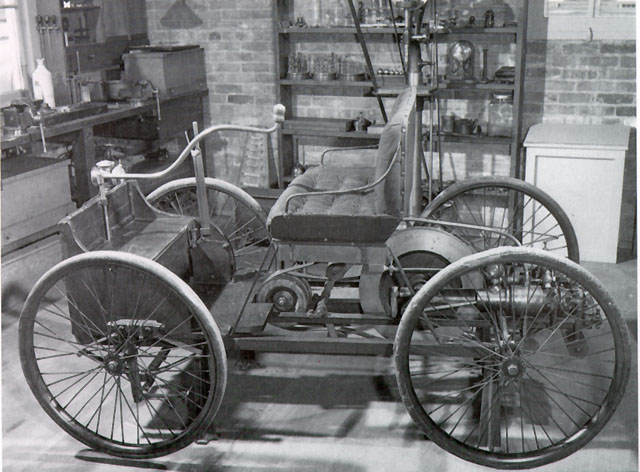 Henry Ford had an engine running by 1893 but it was 1896 before he built his first car. By the end of the year Ford had sold his first car, which he called a Quadracycle, for $200 and used the money to build another one. With the financial backing of the Mayor of Detroit, William C. Maybury and other wealthy Detroiters, Ford formed the Detroit Automobile Company in 1899. A few prototypes were built but no production cars were ever made by this company. It was dissolved in January 1901. Ford would not offer a car for sale until 1903.
Henry Ford had an engine running by 1893 but it was 1896 before he built his first car. By the end of the year Ford had sold his first car, which he called a Quadracycle, for $200 and used the money to build another one. With the financial backing of the Mayor of Detroit, William C. Maybury and other wealthy Detroiters, Ford formed the Detroit Automobile Company in 1899. A few prototypes were built but no production cars were ever made by this company. It was dissolved in January 1901. Ford would not offer a car for sale until 1903.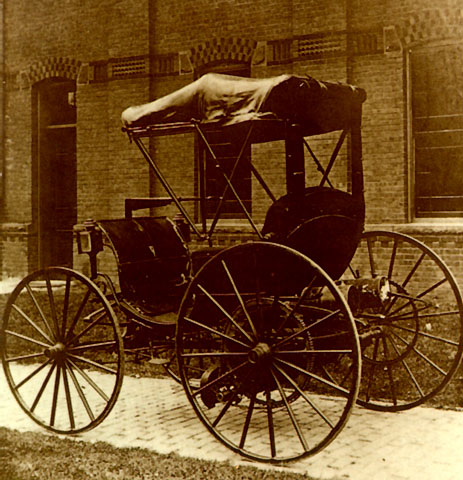 Running by February, 1893 and ready for road trials by September, 1893 the car built by Charles and Frank Duryea, brothers, was the first gasoline powered car in America. The first run on public roads was made on September 21, 1893 in Springfield, MA. They had purchased a used horse drawn buggy for $70 and installed a 4 HP, single cylinder gasoline engine. The car (buggy) had a friction transmission, spray carburetor and low tension ignition. It must not have run very well because Frank didn't drive it again until November 10 when it was reported by the Springfield Morning Union newspaper. This car was put into storage in 1894 and stayed there until 1920 when it was rescued by Inglis M. Uppercu and presented to the United States National Museum.
Running by February, 1893 and ready for road trials by September, 1893 the car built by Charles and Frank Duryea, brothers, was the first gasoline powered car in America. The first run on public roads was made on September 21, 1893 in Springfield, MA. They had purchased a used horse drawn buggy for $70 and installed a 4 HP, single cylinder gasoline engine. The car (buggy) had a friction transmission, spray carburetor and low tension ignition. It must not have run very well because Frank didn't drive it again until November 10 when it was reported by the Springfield Morning Union newspaper. This car was put into storage in 1894 and stayed there until 1920 when it was rescued by Inglis M. Uppercu and presented to the United States National Museum.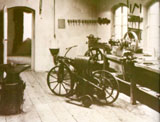 The picture to the left, taken in 1885, is of Gottllieb Daimler's workshop in Bad Cannstatt where he built the wooden motorcycle shown. Daimler's son Paul rode this motorcycle from Cannstatt to Unterturkheim and back on November 10, 1885. Daimler used a hot tube ignition system to get his engine speed up to 1000 rpm
The picture to the left, taken in 1885, is of Gottllieb Daimler's workshop in Bad Cannstatt where he built the wooden motorcycle shown. Daimler's son Paul rode this motorcycle from Cannstatt to Unterturkheim and back on November 10, 1885. Daimler used a hot tube ignition system to get his engine speed up to 1000 rpm
The previous August, Karl Benz had already driven his light, tubular framed tricycle around the Neckar valley, only 60 miles from where Daimler lived and worked. They never met. Frau Berta Benz took Karl's car one night and made the first long car trip to see her mother, traveling 62 miles from Mannheim to Pforzheim in 1888.
Also in August 1888, William Steinway, owner of Steinway & Sons piano factory, talked to Daimler about US manufacturing right and by September had a deal. By 1891 the Daimler Motor Company, owned by Steinway, was producing petrol engines for tramway cars, carriages, quadricycles, fire engines and boats in a plant in Hartford, CT.
Steam cars had been built in America since before the Civil War but the early one were like miniature locomotives. In 1871, Dr. J. W. Carhart, professor of physics at Wisconsin State University, and the J. I. Case Company built a working steam car. It was practical enough to inspire the State of Wisconsin to offer a $10,000 prize to the winner of a 200 mile race in 1878.>
The 200 mile race had seven entries, or which two showed up for the race. One car was sponsored by the city of Green Bay and the other by the city of Oshkosh. The Green Bay car was the fastest but broke down and the Oshkosh car finished with an average speed of 6 mph.
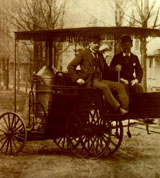 From this time until the end of the century, nearly every community in America had a mad scientist working on a steam car. Many old news papers tell stories about the trials and failures of these would be inventors.
From this time until the end of the century, nearly every community in America had a mad scientist working on a steam car. Many old news papers tell stories about the trials and failures of these would be inventors.
By 1890 Ransom E. Olds had built his second steam powered car, pictured at left. One was sold to a buyer in India, but the ship it was on was lost at sea.
 A1-intake valve
A1-intake valve Nicolas Cugnot who designed the first car in 1769 made another steam-driven vehicle two years later, also at the Paris Arsenal. The machine reportedly ran quite well, although on one occasion it ran into a wall, thus recording the world's first motor-accident. The vehicle may still be seen today in the Conservatoire Nationale des Arts et Metiers in Paris.
Nicolas Cugnot who designed the first car in 1769 made another steam-driven vehicle two years later, also at the Paris Arsenal. The machine reportedly ran quite well, although on one occasion it ran into a wall, thus recording the world's first motor-accident. The vehicle may still be seen today in the Conservatoire Nationale des Arts et Metiers in Paris.The next step towards the development of the car was the invention of the internal combustion engine. Francois Isaac de Rivaz designed the first internal combustion engine in 1807, using a mixture of hydrogen and oxygen to generate energy. Several designs were developed for a car to run on the internal combustion engine during the early 19 th century, but with little to no degree of commercial success due to the fact that there was no known fuel that could be safely internally combusted.
In 1860, Jean Joseph Etienne Lenoir, a Frenchman, built the first successful two-stroke gas driven engine. Two years later, he again built an experimental vehicle by his gas-engine, which ran at a speed of 3 kms/hour and drove it from Paris to Joinville. Both of these cars became popular and by 1865 could be frequently seen on the roads. Unfortunately, Lenoir died broke before he could ever make any money or even enjoy his invention.
 The birth of the car as we know it today took several years and the works and developments of many people. It was not until 1885 that the first car rolled down the streets; however, earlier attempts at steam powered road vehicles were successful, giving people the idea that cars as we know them today have existed for a lot longer than they have.
The birth of the car as we know it today took several years and the works and developments of many people. It was not until 1885 that the first car rolled down the streets; however, earlier attempts at steam powered road vehicles were successful, giving people the idea that cars as we know them today have existed for a lot longer than they have. The first steam-powered vehicle was designed by Nicolas-Joseph Cugnot and constructed by M. Brezin in 1769 and could attain speeds of up to 6 km/hour. Two years later, he designed another, much faster steam-driven engine, which was so fast that it rammed into a wall, recording the world's first car accident. These early steam-powered vehicles were so heavy that they were only practical on a perfectly flat surface as strong as iron. However impractical as these cars may have been, the design for these vehicles were the basis for the first self-propelled vehicles and ultimately the basis for the design of the car we know today.
